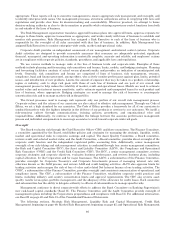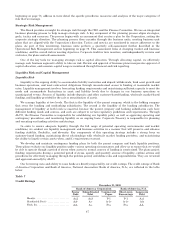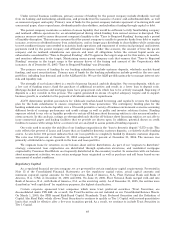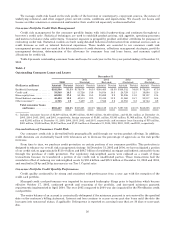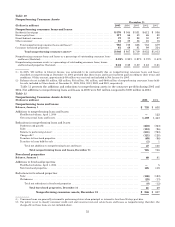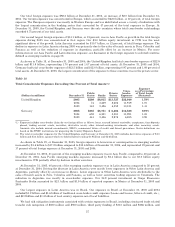Bank of America 2005 Annual Report Download - page 84
Download and view the complete annual report
Please find page 84 of the 2005 Bank of America annual report below. You can navigate through the pages in the report by either clicking on the pages listed below, or by using the keyword search tool below to find specific information within the annual report.Under normal business conditions, primary sources of funding for the parent company include dividends received
from its banking and nonbanking subsidiaries, and proceeds from the issuance of senior and subordinated debt, as well
as commercial paper and equity. Primary uses of funds for the parent company include repayment of maturing debt and
commercial paper, share repurchases, dividends paid to shareholders, and subsidiary funding through capital or debt.
The parent company maintains a cushion of excess liquidity that would be sufficient to fully fund holding company
and nonbank affiliate operations for an extended period during which funding from normal sources is disrupted. The
primary measure used to assess the parent company’s liquidity is the “Time to Required Funding” during such a period
of liquidity disruption. This measure assumes that the parent company is unable to generate funds from debt or equity
issuance, receives no dividend income from subsidiaries, and no longer pays dividends to shareholders while continuing
to meet nondiscretionary uses needed to maintain bank operations and repayment of contractual principal and interest
payments owed by the parent company and affiliated companies. Under this scenario, the amount of time the parent
company and its nonbank subsidiaries can operate and meet all obligations before the current liquid assets are
exhausted is considered the “Time to Required Funding”. ALCO approves the target range set for this metric, in months,
and monitors adherence to the target. Maintaining excess parent company cash that ensures that “Time to Required
Funding” remains in the target range is the primary driver of the timing and amount of the Corporation’s debt
issuances. As of December 31, 2005 “Time to Required Funding” was 29 months.
The primary sources of funding for our banking subsidiaries include customer deposits, wholesale market–based
funding, and asset securitizations. Primary uses of funds for the banking subsidiaries include growth in the core asset
portfolios, including loan demand, and in the ALM portfolio. We use the ALM portfolio primarily to manage interest rate
risk and liquidity risk.
The strength of our balance sheet is a result of rigorous financial and risk discipline. Our excess deposits, which are
a low cost of funding source, fund the purchase of additional securities and result in a lower loan to deposit ratio.
Mortgage-backed securities and mortgage loans have prepayment risk which has to be actively managed. Repricing of
deposits is a key variable in this process. The capital generated in excess of capital adequacy targets and to support
business growth, is available for the payment of dividends and share repurchases.
ALCO determines prudent parameters for wholesale market-based borrowing and regularly reviews the funding
plan for the bank subsidiaries to ensure compliance with these parameters. The contingency funding plan for the
banking subsidiaries evaluates liquidity over a 12-month period in a variety of business environment scenarios assuming
different levels of earnings performance and credit ratings as well as public and investor relations factors. Funding
exposure related to our role as liquidity provider to certain off-balance sheet financing entities is also measured under a
stress scenario. In this analysis, ratings are downgraded such that the off-balance sheet financing entities are not able to
issue commercial paper and backup facilities that we provide are drawn upon. In addition, potential draws on credit
facilities to issuers with ratings below a certain level are analyzed to assess potential funding exposure.
One ratio used to monitor the stability of our funding composition is the “loan to domestic deposit” (LTD) ratio. This
ratio reflects the percent of Loans and Leases that are funded by domestic customer deposits, a relatively stable funding
source. A ratio below 100 percent indicates that our loan portfolio is completely funded by domestic customer deposits.
The ratio was 102 percent at December 31, 2005 compared to 93 percent at December 31, 2004. The increase was
primarily attributable to organic growth in the loan and lease portfolio.
We originate loans for retention on our balance sheet and for distribution. As part of our “originate to distribute”
strategy, commercial loan originations are distributed through syndication structures, and residential mortgages
originated by Consumer Real Estate are frequently distributed in the secondary market. In connection with our balance
sheet management activities, we may retain mortgage loans originated as well as purchase and sell loans based on our
assessment of market conditions.
Regulatory Capital
As a regulated financial services company, we are governed by certain regulatory capital requirements. Presented in
Note 15 of the Consolidated Financial Statements are the regulatory capital ratios, actual capital amounts and
minimum required capital amounts for the Corporation, Bank of America, N.A., Fleet National Bank and Bank of
America, N.A. (USA) at December 31, 2005 and 2004. On June 13, 2005, Fleet National Bank merged with and into
Bank of America, N.A., with Bank of America, N.A. as the surviving entity. As of December 31, 2005, the entities were
classified as “well-capitalized” for regulatory purposes, the highest classification.
Certain corporate sponsored trust companies which issue trust preferred securities (Trust Securities) are
deconsolidated under FIN 46R. As a result, the Trust Securities are not included on our Consolidated Balance Sheets.
On March 1, 2005, the FRB issued Risk-Based Capital Standards: Trust Preferred Securities and the Definition of
Capital (the Final Rule) which allows Trust Securities to continue to qualify as Tier 1 Capital with revised quantitative
limits that would be effective after a five-year transition period. As a result, we continue to include Trust Securities in
Tier 1 Capital.
48










